- Home
- About
- Map
- Trips
- Bringing Boat West
- Migration West
- Solo Motorcycle Ride
- Final Family XC Trip
- Colorado Rockies
- Graduates' XC Trip
- Yosemite & Nevada
- Colorado & Utah
- Best of Utah
- Southern Loop
- Pacific Northwest
- Northern Loop
- Los Angeles to NYC
- East Coast Trips
- Martha's Vineyard
- 1 Week in Quebec
- Southeast Coast
- NH Backpacking
- Martha's Vineyard
- Canadian Maritimes
- Ocracoke Island
- Edisto Island
- First Landing '02
- Hunting Island '02
- Stowe in Winter
- Hunting Island '01
- Lake Placid
- Chesapeake
- Provincetown
- Hunting Island '00
- Acadia in Winter
- Boston Suburbs
- Niagara Falls
- First Landing '99
- Cape Hatteras
- West Coast Trips
- Burning Man
- Utah Off-Roading
- Maui
- Mojave 4WD Course
- Colorado River Rafting
- Bishop & Death Valley
- Kauai
- Yosemite Fall
- Utah Off-Road
- Lost Coast
- Yosemite Valley
- Arizona and New Mexico
- Pescadero & Capitola
- Bishop & Death Valley
- San Diego, Anza Borrego, Joshua Tree
- Carmel
- Death Valley in Fall
- Yosemite in the Fall
- Pacific Northwest
- Utah Off-Roading
- Southern CA Deserts
- Yosemite & Covid
- Lake Powell Covid
- Eastern Sierra & Covid
- Bishop & Death Valley
- Central & SE Oregon
- Mojave Road
- Eastern Sierra
- Trinity Alps
- Tuolumne Meadows
- Lake Powell Boating
- Eastern Sierra
- Yosemite Winter
- Hawaii
- 4WD Eastern Sierra
- 4WD Death Valley +
- Southern CA Deserts
- Christmas in Tahoe
- Yosemite & Pinnacles
- Totality
- Yosemite & Sierra
- Yosemite Christmas
- Yosemite, San Diego
- Yosemite & North CA
- Seattle to Sierra
- Southwest Deserts
- Yosemite & Sierra
- Pacific Northwest
- Yosemite & South CA
- Pacific Northwest
- Northern California
- Southern Alaska
- Vancouver Island
- International Trips
- Index
- Tips
- Books
- Photos/Videos
- Search
- Contact
The Loneliest Road through Nevada
Saturday, September 9, 2023 - 8:15pm by Lolo457 miles and 8 hours from our last stop - 1 night stay
Travelogue
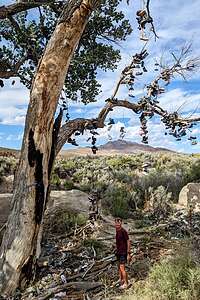 The Shoe TreeOur first planned destination for this trip was Goblin Valley State Park in Utah, 900 miles (15 hours) from home. I love Goblin Valley and was ecstatic that I was able to get the last available campsite.
The Shoe TreeOur first planned destination for this trip was Goblin Valley State Park in Utah, 900 miles (15 hours) from home. I love Goblin Valley and was ecstatic that I was able to get the last available campsite.
To avoid turning this into a death march, we planned to spend 3 days getting, stopping to do some fun stuff along the way.
Our drive would take us all the way across Nevada (from Reno to Baker) on US 50, also known as “The Loneliest Road in America.” They weren’t kidding about the road being lonely. For close to 400 miles, we wound across the entire width of Nevada, passing through an occasional small town (some of which looked like they were left over from the gold rush), but otherwise just miles and miles of mountains, desert, and sagebrush. This road used to be a Pony Express Route.
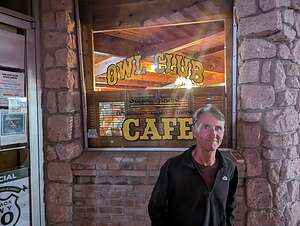 Night out on the townFor the purpose of this writeup, I will use miles from Reno to describe the location of stops.
Night out on the townFor the purpose of this writeup, I will use miles from Reno to describe the location of stops.
The first place of note we passed through (mile 60) was the relatively large (for Nevada) town of Fallon, with 7,000 residents and plenty of shopping malls and food chains. Fallon is home to the U.S. Navy-Fighter Weapons School and is where the film Top Gun: Maverick was filmed.
30 miles after Fallon (mile 90), we passed a sign for Sand Mountain Recreation Area, an OHV area that allows dune buggies to whip around on a 2-mile-long, 600-foot-high sand dune.
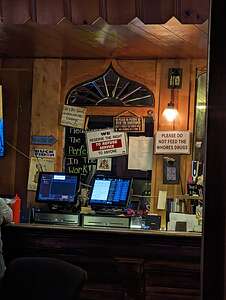 Nevada bar humorHerb has never met a dune he didn’t like, so we vowed to stop here on the way back home, especially when we learned that it is one of a rare group of “singing sand dunes.” There are only about 40 of them in the entire world. We have been to two of them - Kelso Dunes in the Mojave Preserve and Eureka Dunes in Death Valley.
Nevada bar humorHerb has never met a dune he didn’t like, so we vowed to stop here on the way back home, especially when we learned that it is one of a rare group of “singing sand dunes.” There are only about 40 of them in the entire world. We have been to two of them - Kelso Dunes in the Mojave Preserve and Eureka Dunes in Death Valley.
Basically, when you run down the steep part of a dune, the sand avalanches in rivulets and begins to “sing.” The singing is caused by the friction of the sand grains sliding against each other. It sounds a bit like the bass note of a pipe organ or the distant drone of an airplane.
At mile 110, in the tiny town of Middlegate, Nevada, we were told by a friend to keep an eye out for the “Shoe Tree.” We didn’t have to try too hard to find it. All I needed to do was key in “Shoe Tree” in Google Maps. Sure enough, Google directed us to a lone cottonwood tree strung with hundreds of pairs of shoes, in the middle of nowhere set against a barren arid desert and mountains.
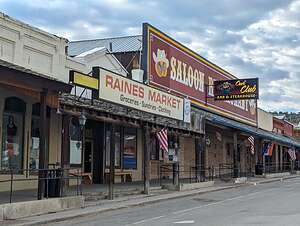 Eureka Main StreetOf course, there is a story behind this strange tree. Who knows if it’s actually true. Anyway, it goes like this: One night while camping under a large cottonwood tree, a newlywed couple got into an argument. When the woman threatened to leave, her newly-minted husband said, “Well, then you’ll have to go barefoot,” and proceeded to throw her shoes up into the tree and drive off to a nearby bar. The bartender, and probably a few beers, convinced the man to go back to the tree and reconcile with his wife, while he did, and they lived happily ever after. Several years later they returned to the tree with their first child and threw his shoes up into the tree under which they had fought and reunited.
Eureka Main StreetOf course, there is a story behind this strange tree. Who knows if it’s actually true. Anyway, it goes like this: One night while camping under a large cottonwood tree, a newlywed couple got into an argument. When the woman threatened to leave, her newly-minted husband said, “Well, then you’ll have to go barefoot,” and proceeded to throw her shoes up into the tree and drive off to a nearby bar. The bartender, and probably a few beers, convinced the man to go back to the tree and reconcile with his wife, while he did, and they lived happily ever after. Several years later they returned to the tree with their first child and threw his shoes up into the tree under which they had fought and reunited.
A Lot of people must fight under this tree, because there were hundreds of them.
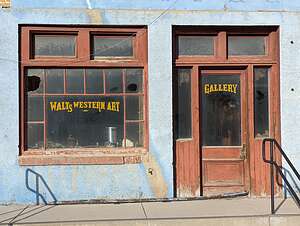 Eureka Art GalleryFor the next 60 miles or so there was pretty much nothing but sagebrush desert. The road began to climb to 6,000 feet as we approached the tiny town of Austin (population 300), on the northern slope of the Toiyabe Mountains at mile 170.
Eureka Art GalleryFor the next 60 miles or so there was pretty much nothing but sagebrush desert. The road began to climb to 6,000 feet as we approached the tiny town of Austin (population 300), on the northern slope of the Toiyabe Mountains at mile 170.
110 miles after Fallon, we climbed the steep Toiyabe Mountains and came to the tiny town of Austin (population 300), another one of Nevada’s silver mining boom towns gone bust. We didn’t stop, but just slowly drove along the steep Main Street through town. If we blinked, we would have missed it.
Leaving Austin, the road climbs steeply to Austin Summit (elevation 7,484) before descending to the longest and flattest stretch of the drive through miles and miles of Great Basin nothingness.
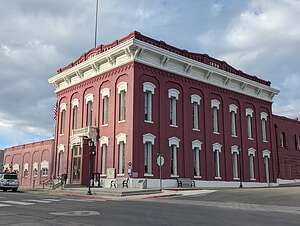 Eureka County Courthouse70 miles past Austin, we arrived in Eureka (mile 243), where we would spend the night. With a population of 480 it wasn’t much bigger than Austin.
Eureka County Courthouse70 miles past Austin, we arrived in Eureka (mile 243), where we would spend the night. With a population of 480 it wasn’t much bigger than Austin.
Eureka is one of the best-preserved mining towns in Nevada. In fact, Eureka County is still mining gold and has one of the largest and productive mines in the country. Along its 4 blocks of franchise-free Main Street are some interesting historic buildings, including the 1879 Eureka County Courthouse (still in use), an old newspaper office (now a museum), and an 1880s opera house.
There weren’t many motel or dining options in towns, but fortunately the SureStay by Best Western and the Owl Cafe and Steakhouse were fine.
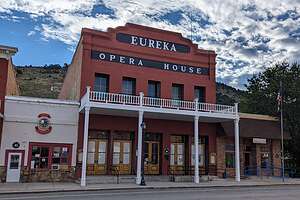 Eureka Opera HouseThe Owl Cafe was hopping, mostly filled with miners and construction workers still in their work clothes. Then it started to fill with tourists passing through. We recognized most of them from our hotel. They must have been short staffed that night because it took us two hours to get our hamburgers. We were just about to walk out (don’t know what we would do instead), when they finally arrived. The hostess was very apologetic and even gave us a 10% discount.
Eureka Opera HouseThe Owl Cafe was hopping, mostly filled with miners and construction workers still in their work clothes. Then it started to fill with tourists passing through. We recognized most of them from our hotel. They must have been short staffed that night because it took us two hours to get our hamburgers. We were just about to walk out (don’t know what we would do instead), when they finally arrived. The hostess was very apologetic and even gave us a 10% discount.
We had made a good dent in our drive to Goblin Valley today - about half of the 15 hours from home. That meant that we could slow the pace down over the next 2 days and stop and have some fun.
Bishop
Thursday, August 24, 2023 - 4:45pm by Lolo190 miles and 4 hours from our last stop - 6 night stay
Travelogue
Now it was on to Andrew and Celeste’s house in Bishop for a 5-day stay.
As I have mentioned in the past, our son Andrew and his wife Celeste, moved from San Francisco to Bishop in 2019 to try out a less-urban lifestyle in what is a world-class rock climbing destination. They were fortunate enough to be able to take their San Francisco jobs with them - and this was before Covid.
Bishop and all of the Eastern Sierra is stunningly beautiful, so even though they are 6 ½ hours away from us now, it is not a hardship to go over the mountains to visit them. Their home is often the first or last stop on one of our road trips.
This time it wasn’t exactly on the way home, but still quicker than going all the way home and back.
The drive on Highway 395 south from Reno, also known as the Eastern Sierra Scenic Byway, is probably one of the most beautiful drives in the U.S. The 133-mile stretch from the Nevada border to Bishop is loaded with scenic vistas, each more beautiful than the next.
Day 1 - South Lake to Long Lake hike
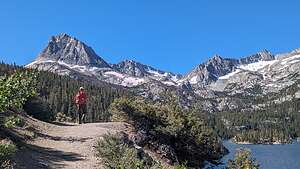 South Lake to Long Lake HikeIt was Friday, which means work day for Andrew and Celeste, so Herb and I decided to do the hike from South Lake to Long Lake, about a half hour drive from their place. We had done this hike back in 2019, and I had gotten terrible altitude sickness. This time I would make sure to drink lots of water along the way.
South Lake to Long Lake HikeIt was Friday, which means work day for Andrew and Celeste, so Herb and I decided to do the hike from South Lake to Long Lake, about a half hour drive from their place. We had done this hike back in 2019, and I had gotten terrible altitude sickness. This time I would make sure to drink lots of water along the way.
The nice thing about hiking in Bishop is that no matter how hot it is (it’s very hot in the summer), you can just drive for 20 to 30 minutes to higher elevations and pretty much dial in the temperature you want. This hike started at 9,750 feet, and we really weren’t acclimated yet.
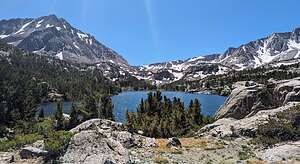 South Lake to Long Lake HikeThe trail to Long Lake starts at the end of South Lake Road (elevation (9,800) and climbs steadily uphill along the eastern shore of lovely South Lake. We continued climbing steadily up until after about 3 miles we reached Long Lake, another stunningly beautiful alpine lake at 10,760 elevation - so we had climbed over 1,000 feet already.
South Lake to Long Lake HikeThe trail to Long Lake starts at the end of South Lake Road (elevation (9,800) and climbs steadily uphill along the eastern shore of lovely South Lake. We continued climbing steadily up until after about 3 miles we reached Long Lake, another stunningly beautiful alpine lake at 10,760 elevation - so we had climbed over 1,000 feet already.
The mosquitoes were terrible at the lake, so I stopped to put mosquito repellent on my arms. I use Picaridin because it doesn’t have Deet. While it definitely worked on my arms, they started biting me right through my shirt, so I had to add more there. I was pretty much covered with bites.
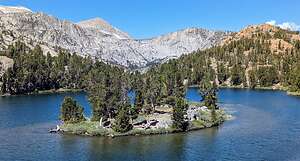 South Lake to Long Lake HikeAfter all that work going uphill, the way back was pretty much all downhill. In total, the hike was about 5 miles with a 1,036 elevation gain. But, it was pretty hard for us because it started at around 9,800 feet, and we were not acclimated yet. Still, the stopping to drink water every half hour definitely held off the altitude sickness I experienced the last time.
South Lake to Long Lake HikeAfter all that work going uphill, the way back was pretty much all downhill. In total, the hike was about 5 miles with a 1,036 elevation gain. But, it was pretty hard for us because it started at around 9,800 feet, and we were not acclimated yet. Still, the stopping to drink water every half hour definitely held off the altitude sickness I experienced the last time.
So no altitude sickness, but this time I had to worry about my mosquito bites, because today’s Inyo Register reported that mosquito pools in Bishop had tested positive for encephalitis and West Nile disease. Oh great.
Andrew and Celeste are terrific hosts, so they prepared dinner for us that night, as they would every night during our stay. What a great Airbnb
Day 2 - Ancient Bristlecones with the Rotary Club
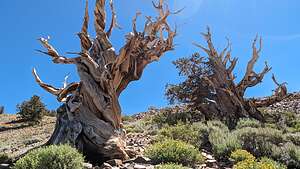 Ancient BristleconesIt was Saturday, so no work for the kids today. Andrew mentioned that their Rotary Club was having a field trip up to the Ancient Bristlecones and that a naturalist would lead us on a hike along the Discovery Trail.
Ancient BristleconesIt was Saturday, so no work for the kids today. Andrew mentioned that their Rotary Club was having a field trip up to the Ancient Bristlecones and that a naturalist would lead us on a hike along the Discovery Trail.
We had been to the Bristlecones before, but not that trail, and not with our own naturalist. So we happily climbed into Andrew’s car and drove down to Big Pine and then east on State Highway 168 up to the Schulman Grove Visitor Center where we would all be meeting.
 Twisted BristleconeIt was a great group of people and our naturalist guide was very fun and informative.
Twisted BristleconeIt was a great group of people and our naturalist guide was very fun and informative.
I already knew that bristlecone pines are the oldest known living trees, but along our 1-mile hike on the Discovery Trail, I learned a few new things from our naturalist guide.
The twisted and seemingly half-dead trunks associated with bristlecones are the result of a trait called sectored architecture. This means each tree root only feeds the part of the tree directly above it. So if a root dies, only the tree section that’s directly connected to that root dies. This trait allows the bristlecone to draw all available water and nutrients to a small percentage of the tree during drought periods. The dead, sculpted trunks are sections the trees let die to save itself in the long term. It is common at high elevations to see bristlecone pines with only one or two living sectors, defined by a strip of bark.
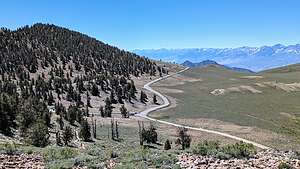 Bristlecone forest on dolomite soil hillThe Ancient Bristlecones also prefer rocky dolomite soils where most other types of vegetation cannot grow. This lack of vegetation helps reduce fire danger, as the isolated Bristlecone trees are often perched on rocky outcroppings with no surrounding surface fuels to catch on fire.
Bristlecone forest on dolomite soil hillThe Ancient Bristlecones also prefer rocky dolomite soils where most other types of vegetation cannot grow. This lack of vegetation helps reduce fire danger, as the isolated Bristlecone trees are often perched on rocky outcroppings with no surrounding surface fuels to catch on fire.
That's why only bristlecones grow on the dolomite hillside, while on the flatter clayier area below, there are no Bristlecones, but only grasses and other shrubs.
It was a very fun and educational day. Thank you Bishop Rotary Club!
Day 3 - Family hang-out day
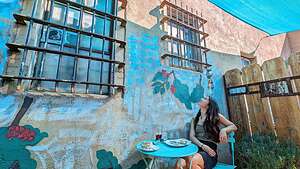 Bishop Coffee ChurchSunday morning in Bishop means Coffee Church, a secular gathering of friends, family, and neighbors at the Indy Roasting Company. In addition to Coffee Pour Overs and Mexican and Scandinavian Coffee Drinks, there are delicious home-made artisan pastries. We try to go there whenever we are in town.
Bishop Coffee ChurchSunday morning in Bishop means Coffee Church, a secular gathering of friends, family, and neighbors at the Indy Roasting Company. In addition to Coffee Pour Overs and Mexican and Scandinavian Coffee Drinks, there are delicious home-made artisan pastries. We try to go there whenever we are in town.
Afterwards it was father-son bonding time with some home maintenance. Herb and Andrew had a very productive day installing recessed lighting in their Family Room ceiling. Andrew has gotten so handy that Herb wants to enlist him to help do the same in our Family Room.
The event we were all looking forward to today, however, was dinner at the Mono Inn to partake in their highly rated 5-course Summer Tasting Menu. Mono Lake is about an hour drive north of Bishop on the highly scenic Highway 395, also known as the Eastern Sierra Scenic Byway.
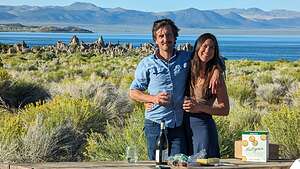 Pre-dinner cocktail hour at the South TufasWe went up a bit ahead of time to have pre-dinner wine and cheese at the South Tufa Reserve on the South side of the lake - a stunning setting, especially during sunset.
Pre-dinner cocktail hour at the South TufasWe went up a bit ahead of time to have pre-dinner wine and cheese at the South Tufa Reserve on the South side of the lake - a stunning setting, especially during sunset.
Then it was on to the historic Mono Inn. Originally established in 1922, the Historic Mono Inn has been a destination for hungry, weary travelers in the eastern Sierra Nevada for decades. Wow, and here we were, four hungry, weary travelers cruising up 395 looking for a good meal over 100 years later.
 Mono Inn ViewIn 1996, the inn was bought by the Ansel Adams family, who remodeled it into a beautiful gallery and restaurant. With its sweeping, majestic view of Mono Lake, it became a cornerstone of fine dining in the area.
Mono Inn ViewIn 1996, the inn was bought by the Ansel Adams family, who remodeled it into a beautiful gallery and restaurant. With its sweeping, majestic view of Mono Lake, it became a cornerstone of fine dining in the area.
In 2007, Sarah Adams (Ansel Adams’ granddaughter) closed the Inn and moved back to the coast. It changed hands a bit for the next 14 years, but has been under new ownership since May 2021. All I could find on the internet is that the new owner is named Hillary and the Chef is Jason Custer.
I had never been here before, but whatever they have done is incredible. The food is creative and delicious, the service is impeccable, and the views are amazing.
What a great experience!
Day 4 - Little Lakes to Gem Lake
 Little Lake to Gem Lakes hikeAnother day, another awesome hike, once again at a higher elevation than Bishop to escape the Bishop heat. It’s nice how you can pretty much dial in the temperature you want by just driving to a trailhead at a higher elevation.
Little Lake to Gem Lakes hikeAnother day, another awesome hike, once again at a higher elevation than Bishop to escape the Bishop heat. It’s nice how you can pretty much dial in the temperature you want by just driving to a trailhead at a higher elevation.
Today’s hike was to be a longer one - an 8-mile, out-and-back hike from the Rock Creek parking lot past several alpine lakes to Gem Lake, which is at an elevation of a little over 11,000 feet. That’s pretty high, so I would have to make sure that I stopped frequently to drink enough water to fend off the altitude sickness which I tend to be susceptible to.
 Little Lakes to Gem Lakes hikePlus, I proactively put on insect repellent after my mosquito experience on the Long Lake hike, especially after learning that mosquito pools around Bishop had recently tested positive for encephalitis.
Little Lakes to Gem Lakes hikePlus, I proactively put on insect repellent after my mosquito experience on the Long Lake hike, especially after learning that mosquito pools around Bishop had recently tested positive for encephalitis.
This is an extremely popular hike, so the parking lot was already full when we got there around 11:00 am - a bit late for hikers. We had to drive back down the road a half mile to another lot, adding 1 mile to our already long 8-mile hike.
From the real parking lot, we set out on a fairly flat trail that parallels Rock Creek, with nice mountain views along the way. There was also plenty of colorful lupine and Indian paintbrush to even further improve the scenery.
 Getting closer to Gem LakeWe passed several pretty alpine lakes along the way - Mack Lake, Marsh Lake, Heart Lake, Box Lake, and then Long Lake, where we stopped to eat our lunch. By now we had hiked about 2.5 miles and only climbed about 350 feet.
Getting closer to Gem LakeWe passed several pretty alpine lakes along the way - Mack Lake, Marsh Lake, Heart Lake, Box Lake, and then Long Lake, where we stopped to eat our lunch. By now we had hiked about 2.5 miles and only climbed about 350 feet.
After lunch we continued walking along Long Lake for about a half mile before beginning another ascent, probably the steepest part of the trail.
 Gem Lake at lastWe skipped the detour to Chickenfoot Lake and began ascending the main trail towards Morgan Pass and Gem Lakes. To get to Gem Lake, we had to cross a stream by balancing our way over a few logs and rocks that seemed to be placed to ensure an easy crossing.
Gem Lake at lastWe skipped the detour to Chickenfoot Lake and began ascending the main trail towards Morgan Pass and Gem Lakes. To get to Gem Lake, we had to cross a stream by balancing our way over a few logs and rocks that seemed to be placed to ensure an easy crossing.
After a bit more ascent, we passed several of the gem lakes before arriving at the final and largest of the Gem Lakes, situated in a bowl below sheer granite faces and steep boulder fields. The water was a brilliant turquoise blue.
It was so beautiful that we hung out there for a bit before heading back. All in all, it was 9 miles with 1,122 feet of elevation gain, which isn’t much for that distance.
Then it was back to Bishop for another great dinner and evening with Andrew and Celeste.
Day 5 - Convict Lake chill day
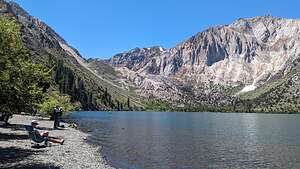 Chilling at Convict LakeWe briefly considered doing a 10-mile, 3,000-foot elevation gain hike to the Big Pine Lakes today, but then reconsidered and instead decided to bring our kindles and relax and read beside beautiful Convict Lake, another one of the Eastern Sierra gems.
Chilling at Convict LakeWe briefly considered doing a 10-mile, 3,000-foot elevation gain hike to the Big Pine Lakes today, but then reconsidered and instead decided to bring our kindles and relax and read beside beautiful Convict Lake, another one of the Eastern Sierra gems.
Unlike the other stunning alpine lakes we had hiked to this week, this one can be driven right up to. The distance from our car to the lake was probably 20 yards. Perfect!
Carved out by glaciers, this beautiful oblong-shaped lake is filled with turquoise-blue water as clear as glass, and surrounded by a box canyon set in the mountains. Mount Morrison, the tallest mountain in the area at 12,241 feet, rises above the southeast end of the lake.
 Convict LakeThe lake is known for its great trout fishing, but I couldn’t get Herb to trade his kindle for a fishing rod.
Convict LakeThe lake is known for its great trout fishing, but I couldn’t get Herb to trade his kindle for a fishing rod.
There is an interesting story behind how Convict Lake got its name. Way back in 1871, a group of convicts escaped from a prison in Carson City, Nevada, and took refuge near the lake, which was then called Monte Diablo. They were pursued by a posse and a shootout began, killing a number of both posse members and convicts. The large peaks above the lake were renamed after the fallen posse members and the lake itself became known as Convict.
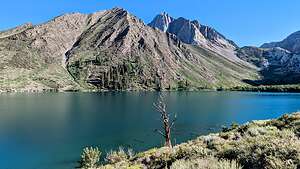 Convict LakeWe spent a very pleasant few hours reading our books, occasionally looking up to take in the scenery and watch the pontoon boats leisurely cruise along the lake.
Convict LakeWe spent a very pleasant few hours reading our books, occasionally looking up to take in the scenery and watch the pontoon boats leisurely cruise along the lake.
At 4:00, we decided it was time to move our bodies a bit, so we took the lovely 3-mile stroll around the perimeter of the lake. About halfway around, we had to take off our shoes to cross the Convict Creek inlet, which covered a good 30 feet or so of the trail.
So, it was another great day in the Eastern Sierra.
Tomorrow we would head back home to Sonoma Valley. There was so much variety along this trip that it felt like we had been away for a month.
Virginia City
Thursday, August 24, 2023 - 9:00am by Lolo30 miles and 0.75 hours from our last stop
Travelogue
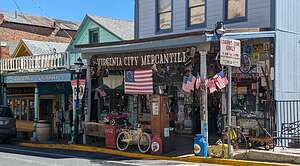 Virginia CityOn our way to Bishop, we decided to take a slight detour to go through Virginia City, a place I have always been interested in visiting. In fact, if I knew how cool it was, I would have suggested driving an extra half hour last night, rather than staying in Reno. It would have been much more fun to eat in a saloon and stay in an old period house.
Virginia CityOn our way to Bishop, we decided to take a slight detour to go through Virginia City, a place I have always been interested in visiting. In fact, if I knew how cool it was, I would have suggested driving an extra half hour last night, rather than staying in Reno. It would have been much more fun to eat in a saloon and stay in an old period house.
But at least we were here now, so I intended to enjoy it. Since we moved out West, we’ve been to many ghost towns and mining sites. Virginia City is not by any means a ghost town, but rather a boom and bust town that rediscovered itself as a valuable, tastefully done, tourist attraction.
But first, a little bit of its history...
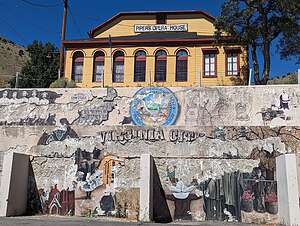 Virginia CityIn 1859, just a decade after the California Gold Rush, an incredible amount of silver was discovered along the eastern slope of Mt. Davidson near Virginia City. Named the Comstock Lode, after Henry Comstock, the part-owner of the property it was discovered on, was one of the most important mining discoveries in American History and virtually ended the California Gold Rush.
Virginia CityIn 1859, just a decade after the California Gold Rush, an incredible amount of silver was discovered along the eastern slope of Mt. Davidson near Virginia City. Named the Comstock Lode, after Henry Comstock, the part-owner of the property it was discovered on, was one of the most important mining discoveries in American History and virtually ended the California Gold Rush.
This was the first major silver strike in the U.S. and one of the richest in the country's history. From 1860 to 1889 , almost seven million tons of ore were extracted and milled, producing what today would equal approximately $700 million in profits.
This wealth came to the attention of President Lincoln and was used to help finance the Union war effort to defeat the southern states during the Civil War.
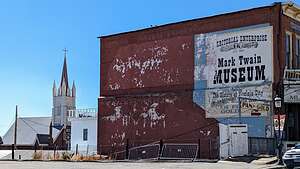 Virginia CityThe population of Virginia City and nearby Gold Hill grew from 4,000 in 1862 to a thriving metropolis of 25,000 residents in 1874. In the 1870s, Virginia City was one of the most important cities between Chicago and the West Coast, and even rivaled San Francisco. At its peak it had 25 theaters, over 100 saloons, five police precincts, a lively red-light district, and multiple newspapers. One of those newspapers, the Territorial Enterprise, hired a young reporter named Samuel Clemens. It was while working in Virginia City that he first called himself Mark Twain.
Virginia CityThe population of Virginia City and nearby Gold Hill grew from 4,000 in 1862 to a thriving metropolis of 25,000 residents in 1874. In the 1870s, Virginia City was one of the most important cities between Chicago and the West Coast, and even rivaled San Francisco. At its peak it had 25 theaters, over 100 saloons, five police precincts, a lively red-light district, and multiple newspapers. One of those newspapers, the Territorial Enterprise, hired a young reporter named Samuel Clemens. It was while working in Virginia City that he first called himself Mark Twain.
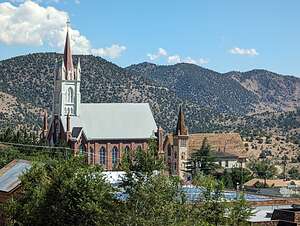 Virginia CityAs happens with most boomtowns, bust followed boom, and by 1881, the Comstock Lode was exhausted. Then the next shiny object (literally) was discovered in Bodie, CA (which we have also visited), and thousands of people in the District began to leave for better opportunities there and elsewhere.
Virginia CityAs happens with most boomtowns, bust followed boom, and by 1881, the Comstock Lode was exhausted. Then the next shiny object (literally) was discovered in Bodie, CA (which we have also visited), and thousands of people in the District began to leave for better opportunities there and elsewhere.
Virginia City’s population shrank to a few hundred people, who, fortunately for us, became the custodians for hundreds of 19th-century buildings, abandoned mine shafts and tunnels and countless documents and photographs pertaining to the Comstock District's boom period.
Today, the Virginia City Historic District is a remarkable collection of over 400 buildings – most dating from the 19th-century and abandoned mine shafts, and still retains the feel of a 19th century western mining town.
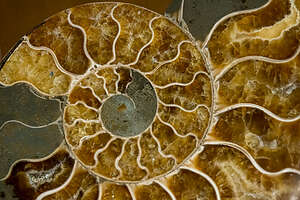 Out beautiful ammoniteI love history and had totally absorbed myself in Colonial American history when we lived on the East Coast. Now, I am very much enjoying learning the very different history of the settlement and growth of the West.
Out beautiful ammoniteI love history and had totally absorbed myself in Colonial American history when we lived on the East Coast. Now, I am very much enjoying learning the very different history of the settlement and growth of the West.
On the main drag, we were attracted to the window display of rocks and minerals in the front window of a store right on the main drag called Stone Age Quarry. In particular, we were both drawn to a beautiful pair of spiral shells, sort of like a nautilus, but more colorful.
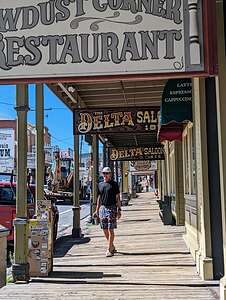 My sensitive cowboyNow, Herb and I are not big shoppers, so it was a bit surprising to both of us that we went inside to inquire about what it was. The very friendly and informative owner of the store said that the pair were the shells from an organism called an Ammonite, which died out about 66 million years ago. Fossils of them are found all around the world. This particular pair came from Madagascar.
My sensitive cowboyNow, Herb and I are not big shoppers, so it was a bit surprising to both of us that we went inside to inquire about what it was. The very friendly and informative owner of the store said that the pair were the shells from an organism called an Ammonite, which died out about 66 million years ago. Fossils of them are found all around the world. This particular pair came from Madagascar.
The lines on the shell are called “sutured patterns” and they became increasingly complex as the organism evolved. They were absolutely beautiful.
$48 for the pair seemed reasonable, so the pair is now proudly displayed in my bookcase.
Oh, and kudos to Herb for being brave enough to strut past the saloons on Main Street with his very colorful rock climbing shorts and Chaco sandals, rather than jeans and cowboy boots, clutching our beautiful ammonite.
Reno
Wednesday, August 23, 2023 - 1:45pm by Lolo427 miles and 7.5 hours from our last stop - 1 night stay
Travelogue
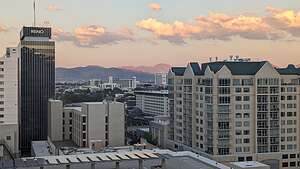 Reno skylineI’m not a big Reno fan, but we had already driven over 7 hours and it had the most options. Ignoring our son’s advice that the River District was a bit sketchy, we booked a room at the Plaza Resort Club Hotel, right near the river.
Reno skylineI’m not a big Reno fan, but we had already driven over 7 hours and it had the most options. Ignoring our son’s advice that the River District was a bit sketchy, we booked a room at the Plaza Resort Club Hotel, right near the river.
We also picked it for two other reasons: it did not have a casino, and it had a free self-parking, parking garage.
That parking garage turned out to be a bit of a problem because we barely got in because our roof rack was just about scraping the top of the garage.
However, the room was very nice and had a great view of the city, but our son was right, the neighborhood was a bit sketchy with homeless people, and one in particular having quite an argument with himself.
We needed to eat something, so we walked to the Pizza Collective, not too far from our hotel. Instead of eating it there, we got it to go, because our room had a really large table, right near the window overlooking the city.
The pizza was good, the bed was comfortable, and the price was right. That’s all we needed.
Eugene
Tuesday, August 22, 2023 - 10:30am by Lolo225 miles and 3.5 hours from our last stop - 1 night stay
Travelogue
 Campbell House InnAs I mentioned in the previous post, even on long-driving days, we like to find something to look forward to at the end of the day. Originally it was supposed to be the Bend area of Oregon, but the air quality was just too awful to make that any fun.
Campbell House InnAs I mentioned in the previous post, even on long-driving days, we like to find something to look forward to at the end of the day. Originally it was supposed to be the Bend area of Oregon, but the air quality was just too awful to make that any fun.
So, as Herb drove, I played on my phone looking for something that would be fun and that we could arrive at no later than 6 pm to have time to enjoy.
Then there it was - the lovely historic Campbell House Inn in Eugene, Oregon, a lovely historic B&B and a cool town that we had never been to before.
 Campbell House GazeboThe Inn did not disappoint. The Inn, which was originally a home built in 1892, had been fully restored as a luxurious boutique hotel. It was situated on an acre of beautifully landscaped grounds, right in the historic district of Eugene. I couldn’t understand why it was only $140 per night (including a sumptuous breakfast), when our crappy little hotel room in Port Angeles cost over $200. Apparently that still annoys me.
Campbell House GazeboThe Inn did not disappoint. The Inn, which was originally a home built in 1892, had been fully restored as a luxurious boutique hotel. It was situated on an acre of beautifully landscaped grounds, right in the historic district of Eugene. I couldn’t understand why it was only $140 per night (including a sumptuous breakfast), when our crappy little hotel room in Port Angeles cost over $200. Apparently that still annoys me.
Each of the rooms were named after a Campbell family member. We were staying in the “Alfred,” which for some reason cracked us up.
Anyway, we started our evening with a glass of wine in the gazebo in the garden. We were having such a nice time that we almost forgot about dinner. Not wanting to go anywhere at that point, we ate some Pad Thai Salad that we had bought in a Ucluelet supermarket.
Then I gave our private bathtub jacuzzi a whirl and almost overflowed the bubbles from my relaxing bubble bath.
 5th Street MarketThe next morning we figured we should explore Eugene before moving on.
5th Street MarketThe next morning we figured we should explore Eugene before moving on.
But first the complimentary breakfast in the Inn’s lovely dining room, which included eggs, sausage, veggies, and freshly baked scones. The setting and the food were wonderful.
After breakfast we headed over to nearby Alton Baker Park to walk along the Prefontaine Trail. Anyone with a son that ran track in high school or college knows of Steve Prefontaine, the legendary track star at the University of Oregon in the 1970s. Sadly, he tragically died in a car accident in 1975 when he was only 24 years old and at the height of his running career.
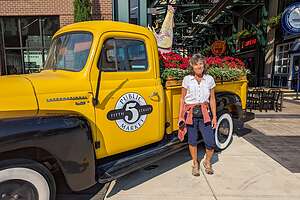 Lolo at the 5th Street MarketThe night before every track meet in high school, our sons and a few of their teammates would gather to eat pasta and watch the Prefontaine movie. They must have seen it a hundred times.
Lolo at the 5th Street MarketThe night before every track meet in high school, our sons and a few of their teammates would gather to eat pasta and watch the Prefontaine movie. They must have seen it a hundred times.
After his untimely death, the city of Eugene built the Prefontaine Trail in nearby Alton Baker Park. In 2019 it was designated a city history landmark. Of course, we had to walk along it. We would have more appropriately run if it hadn’t been for that gigantic breakfast at the Campbell House Inn.
Our next stop was the 5th Street PublicMarket, the area’s premier open-air shopping destination with up-scale stores, restaurants, bars, tasting rooms, and cafes. It was quite a lively place.
Ok, time to continue on to Bishop, probably finding another place to stop along the way.
Description
44.05708144665744, -123.0900370075083
Hurricane Ridge (Olympic National Park)
Tuesday, August 22, 2023 - 8:30am by Lolo170 miles and 4 hours from our last stop - 1 night stay
Travelogue
 Hurricane Hill TrailWe woke up in our Port Angeles motel to bright sunshine, which meant we would finally be able to do the Hurricane Hill hike in nearby Olympic National Park. We had been thwarted twice already - once two years ago when the weather was awful, and our way up the coast a week ago when the Hurricane Ridge Road was closed for tree removal.
Hurricane Hill TrailWe woke up in our Port Angeles motel to bright sunshine, which meant we would finally be able to do the Hurricane Hill hike in nearby Olympic National Park. We had been thwarted twice already - once two years ago when the weather was awful, and our way up the coast a week ago when the Hurricane Ridge Road was closed for tree removal.
The Hurricane Hill trail starts at the end of Hurricane Ridge Road. Even though we got there early, the parking lot was full, so we drove a short distance back to the overflow parking.
From there we walked on a past through the woods to the actual trailhead. The trail is paved and quite easy, but it did lead us through a beautiful subalpine meadow with spectacular views of the glacier-covered Olympic Mountains and the Strait of Juan de Fuca.
 Hurricane Hill TrailThe trail is 3.2 miles out-and-back (with 800 foot elevation gain), but we managed to do over 4 because we were running around so much at the top enjoying all the views.
Hurricane Hill TrailThe trail is 3.2 miles out-and-back (with 800 foot elevation gain), but we managed to do over 4 because we were running around so much at the top enjoying all the views.
Okay, now that we checked off this hike, I think we have pretty much seen and done all of Olympic National Park.
Actually, there was something we hadn’t done - the section of the Olympic Loop Scenic Drive from Port Townsend to Olympia. It was a beautiful drive, tracing the shores of the Hood Canal for a good part of it. Unfortunately, Herb slept through most of it, as he likes to do when I take over the wheel.
 Hurricane Hill TrailNow it was time to head south towards Bishop, California where our son and daughter-in-law live. It wasn’t exactly on the way home, but we missed them, and Bishop is such a beautiful place that we pointeds the car in that direction. Google Maps told us it would take 16 hours to get there, so we started thinking about places to stop along the way.
Hurricane Hill TrailNow it was time to head south towards Bishop, California where our son and daughter-in-law live. It wasn’t exactly on the way home, but we missed them, and Bishop is such a beautiful place that we pointeds the car in that direction. Google Maps told us it would take 16 hours to get there, so we started thinking about places to stop along the way.
Originally we were hoping to spend some time in the Bend, Oregon area, but the smoke was so bad that Oregon was going to pretty much be a drive-through state this time.
So our plan was to just keep driving until we felt like stopping, hopefully some place that would be fun in some way. We didn't want to go much more than 4 hours.
Then I found the Campbell House Inn in Eugene, Oregon, a highly-rated B&B with a lovely garden with gazebos and adirondack chairs to sit in. Oh, and a jacuzzi in the bathroom. Sounded perfect!
Description
47.93314492065909, -123.40964663498389
Butchart Gardens
Monday, August 21, 2023 - 3:45pm by Lolo30 miles and 0.75 hours from our last stop
Travelogue
 Sunken GardenAs I mentioned in the previous stop, we had a whole afternoon to devote to visiting the highly-acclaimed Butchart Gardens, because our ferry back to the U.S. didn’t leave until 7:30 in the evening.
Sunken GardenAs I mentioned in the previous stop, we had a whole afternoon to devote to visiting the highly-acclaimed Butchart Gardens, because our ferry back to the U.S. didn’t leave until 7:30 in the evening.
The Butchart Gardens are not in the city of Victoria, as I originally thought, but a half hour north in the town of Brentwood.
Butchart Gardens has a fascinating history. It all began in 1902 , when Robert and Jennie Butchard moved to Vancouver Island to build a cement plant on a rich limestone deposit at Tod Inlet.
 Sunken GardemWhen the limestone quarry was exhausted, Jennie envisioned creating a grand garden in the depleted quarry. That old quarry is now the Sunken Garden, the most beautiful and popular garden on the property.
Sunken GardemWhen the limestone quarry was exhausted, Jennie envisioned creating a grand garden in the depleted quarry. That old quarry is now the Sunken Garden, the most beautiful and popular garden on the property.
.thumbnail.jpg) Afternoon TeaOver the following decades they continued transforming their property into a botanical garden, traveling extensively throughout the world, collecting rare shrubs, trees, and plants which they transplanted in their gardens. Footpaths, bridges, waterfalls, ponds, and fountains were later added. The gardens now contain over 5,000 varieties of flowers.
Afternoon TeaOver the following decades they continued transforming their property into a botanical garden, traveling extensively throughout the world, collecting rare shrubs, trees, and plants which they transplanted in their gardens. Footpaths, bridges, waterfalls, ponds, and fountains were later added. The gardens now contain over 5,000 varieties of flowers.
Between 1906 and 1929, the Butcharts expanded The Gardens, designing the Japanese Garden on the seaside, the Italian Garden on their former tennis court and the Rose Garden in their old kitchen vegetable garden.
In 1939, the Butcharts gave the Gardens to their grandson Ian Ross on his 21st birthday. Over the next 58 years, he transformed the gardens into a world-renowned attraction, adding outdoor concerts and night lighting in the summers, and the Magic of Christmas in the winters.
It was a real family affair. In 1977 great-grandson Christopher began producing a choreographed firework show every year. In 2009, his sister, and current owner of The Gardens, Robin, added the Children’s Pavilion and Menagerie Carousel.
 Italian GardensIn 2004, on the 100th anniversary of the Gardens, two Totem Poles, carved in Classic Coast Salish style by Master Carvers Charles Elliot of the Tsartlip Nation and Doug La Fortune of Tsawout Band, were placed in the Gardens in recognition of the rich cultural heritage provided by Indigenous People.
Italian GardensIn 2004, on the 100th anniversary of the Gardens, two Totem Poles, carved in Classic Coast Salish style by Master Carvers Charles Elliot of the Tsartlip Nation and Doug La Fortune of Tsawout Band, were placed in the Gardens in recognition of the rich cultural heritage provided by Indigenous People.
Today, The Butchart Gardens is a National Historic Site of Canada. It receives over a million visitors a year.
Ownership of the Gardens remains within the Butchart family. Great-granddaughter Robin-Lee Clarke is the current owner and managing director.
.thumbnail.jpg) Sturgeon StatueA visit to The Gardens wouldn’t be complete without partaking in Afternoon Tea. We almost blew this though because we didn’t know you should make reservations. But it did work out, and we were able to enjoy an indulgent variety of English trifles, savory sandwiches, fresh scones, and lots of house-made sweets in their lovely dining room. Oh, and of course, tea.
Sturgeon StatueA visit to The Gardens wouldn’t be complete without partaking in Afternoon Tea. We almost blew this though because we didn’t know you should make reservations. But it did work out, and we were able to enjoy an indulgent variety of English trifles, savory sandwiches, fresh scones, and lots of house-made sweets in their lovely dining room. Oh, and of course, tea.
Our plan all along was have our ample Amethyst Inn breakfast and our Afternoon Tea get us through the day, so we wouldn’t need dinner before the ferry. As we expected, there was so much food at the tea that we got a doggy bag to bring on the ferry.
The cost for the Afternoon Tea was $40.95 per person (about $30 U.S.), plus the $39.50 per person Admission to the Gardens (about $29), but it was worth every penny of it.
Then it was back to the Victoria ferry for our return to Port Angeles.
 Ross FountainI think everyone on the ferry around us was jealous of our fancy snacks. I think we were the only passengers munching on Raspberry pistachio truffle, Carrot cake, Baked lemon custard, Strawberry mousse, and a Chocolate ganache torte.
Ross FountainI think everyone on the ferry around us was jealous of our fancy snacks. I think we were the only passengers munching on Raspberry pistachio truffle, Carrot cake, Baked lemon custard, Strawberry mousse, and a Chocolate ganache torte.
Since we were too happy with our stay at the Angeles Motel on the way over, we figured we would try the Super 8 by Wyndham. It was a bit better but still a rip-off at $231, and that’s U.S. dollars.
Oh well, at least it positioned us well for going back into Olympic National Park in the morning to hike Hurricane Ridge.
Victoria
Sunday, August 20, 2023 - 3:30pm by Lolo52 miles and 1.5 hours from our last stop - 1 night stay
Travelogue
 Lolo arrives at the Amethyst InnI have to admit that Victoria was a lot bigger and more urbanized than I expected, so I’m kind of glad we stayed in a cute little Victorian B&B called the Amethyst Inn, away from the hustle and bustle of downtown. When in Rome…be a Victorian.
Lolo arrives at the Amethyst InnI have to admit that Victoria was a lot bigger and more urbanized than I expected, so I’m kind of glad we stayed in a cute little Victorian B&B called the Amethyst Inn, away from the hustle and bustle of downtown. When in Rome…be a Victorian.
Oh, and I am so glad we did. The Inn is a fully-restored historic mansion dating back to 1885, and it was absolutely amazing. Our room had 13-foot-ceilings, period furniture and antiques, a cozy fireplace, and a bathroom larger than most people’s living rooms, complete with a giant jacuzzi.
 Lolo adjusting to the life of a VictorianWe only had one night here, so we probably should have been out exploring the city, but not before first testing out the jacuzzi. At first we thought it was broken, until we realized we had to flip the outlet switch in the bathroom.
Lolo adjusting to the life of a VictorianWe only had one night here, so we probably should have been out exploring the city, but not before first testing out the jacuzzi. At first we thought it was broken, until we realized we had to flip the outlet switch in the bathroom.
Finally we filled it with water, added bubbles, and turned on the jets. I felt so decadent. It was great.
 Craigdarroch CastleEventually we dragged ourselves out of the jacuzzi and set out to explore the town. Rather than drive, we decided to walk down Fort Street to the Inner Harbor (or Harbour as they call it).
Craigdarroch CastleEventually we dragged ourselves out of the jacuzzi and set out to explore the town. Rather than drive, we decided to walk down Fort Street to the Inner Harbor (or Harbour as they call it).
Not far from the Amethyst Inn, we made a quick side trip to the Craigdarroch Castle, which unfortunately had already closed for the day. Too bad, because I would have loved to have seen the interior of what was known as a “bonanza castle” - a massive mansion built for entrepreneurs who became wealthy during the industrial age. In this case, the entrepreneur was Robert Dunsmuir, a Scottish immigrant who made his fortune from Vancouver Island coal.
 Dinner at Frankie'sWe did, however, enjoy wandering around the exterior.
Dinner at Frankie'sWe did, however, enjoy wandering around the exterior.
We continued down Fort Street with the intention of eating at Red Fish Blue Fish, a very popular dockside restaurant right on the harbor, but the line was a mile long.
So, we went back to Government Street, the main drag in terms of restaurants and strolled south towards the Empress Hotel looking for a place to eat. Everything looked pretty crowded.
 The iconic Empress HotelWe finally settled on Frankie’s Modern Diner, which turned out to be a good choice - lots of variety, big portions, high quality, quick service, and good value.
The iconic Empress HotelWe finally settled on Frankie’s Modern Diner, which turned out to be a good choice - lots of variety, big portions, high quality, quick service, and good value.
After dinner, we continued strolling south to Victoria’s Inner Harbour, the scenic area of the waterfront with Victoria’s main tourist attractions - the Empress Hotel and the British Columbia Parliament Buildings, both extremely impressive structures, especially the Parliament Buildings whose facades were outlined in white lights.
 The Crystal GardenThe Empress is the crown jewel on Victoria’s waterfront. Like the U.S. National Park lodges, the idea for the elegant, chateau-styled Empress was conceived by a railroad, in this case the Canadian Pacific Railway, as a way of attracting affluent steam and rail customers.
The Crystal GardenThe Empress is the crown jewel on Victoria’s waterfront. Like the U.S. National Park lodges, the idea for the elegant, chateau-styled Empress was conceived by a railroad, in this case the Canadian Pacific Railway, as a way of attracting affluent steam and rail customers.
It was designed by celebrated architect Francis Rattenbury, who also designed the nearby iconic Parliament Building. The Empress Hotel opened in 1908, and it became, and still is, the social and business center of the city.
 Glass and mirrors everywhereIt was designated a National Historic Site of Canada in 1981.
Glass and mirrors everywhereIt was designated a National Historic Site of Canada in 1981.
If we weren’t already planning to have afternoon tea at Butchart Gardens, the following day, I would have loved to experience afternoon tea here. It is the number one thing that most people associate with the Empress.
Behind the Empress Hotel, is a greenhouse garden called the Crystal Garden. It too was designed by Francis Rattenbury, as well as Percy L. James. It was inspired by London’s more famous Crystal Palace.
 Parliament BuildingsIt began as an indoor saltwater swimming pool and dance hall in 1925, commissioned (like the Empress Hotel) by the Canadian Pacific Railway as a way to attract visitors to the city. It continued as that until it was converted to a conservatory in 1980, and is now a Conference Center with a tropical garden of lush plants, exotic birds and mammals.
Parliament BuildingsIt began as an indoor saltwater swimming pool and dance hall in 1925, commissioned (like the Empress Hotel) by the Canadian Pacific Railway as a way to attract visitors to the city. It continued as that until it was converted to a conservatory in 1980, and is now a Conference Center with a tropical garden of lush plants, exotic birds and mammals.
Its use of glass and steel was unique in Canada at the time of its construction, and reminiscent of railway architecture and the use of glass-enclosed spaces.
We entered the Crystal Garden by walking through the lobby of The Empress. Surprisingly, we had the whole place to ourselves.
 Back home to the Amethyst InnFrancis Rattenbury must have been a very busy man, because he also designed the iconic Parliament Buildings, which are a dominant feature of the Inner Harbour. The buildings are the official residence for the B.C. Parliament to pass laws and the Provincial Legislative Assembly to pass laws gather and discuss the direction of the province. It was too bad that we weren’t in Victoria long enough to take one of the guided tours through the buildings.
Back home to the Amethyst InnFrancis Rattenbury must have been a very busy man, because he also designed the iconic Parliament Buildings, which are a dominant feature of the Inner Harbour. The buildings are the official residence for the B.C. Parliament to pass laws and the Provincial Legislative Assembly to pass laws gather and discuss the direction of the province. It was too bad that we weren’t in Victoria long enough to take one of the guided tours through the buildings.
It was such a nice night that we decided to walk the 2 miles back to the Amethyst Inn.
.thumbnail.jpg) Victorian breakfast at the Amethyst InnThe next morning, I was very much looking forward to enjoying the Inn’s highly acclaimed breakfast. We sauntered down the staircase like a Victorians and entered the elegant dining room where the tables were set with old china, silverware, and cut glass on white linen tablecloths - just like at home.
Victorian breakfast at the Amethyst InnThe next morning, I was very much looking forward to enjoying the Inn’s highly acclaimed breakfast. We sauntered down the staircase like a Victorians and entered the elegant dining room where the tables were set with old china, silverware, and cut glass on white linen tablecloths - just like at home.
The breakfast was amazing - three courses including a fresh fruit parfait, delicious omelet, and home baked croissants and scones.
Sadly, we only had one night in Victoria and had to check out this morning. However, since our ferry to Port Angeles wasn’t until 7:30 tonight, we had the whole day to explore.
 Fisherman' WharfWe planned to spend the entire afternoon at the famous Butchart Gardens, but first we wanted to see Fisherman’s Wharf before leaving Victoria. Although it is close to the Inner Harbour, we didn’t have time to explore here last night.
Fisherman' WharfWe planned to spend the entire afternoon at the famous Butchart Gardens, but first we wanted to see Fisherman’s Wharf before leaving Victoria. Although it is close to the Inner Harbour, we didn’t have time to explore here last night.
Plus, it was much better in the daylight to enjoy the colorful floating homes, or houseboats, as I would call them. The Victoria Harbour Authority has set aside 33 berths in the marina for floating residences. All of them are occupied and cannot be rented. Too bad, because they would be great Airbnbs.
What a fun place to live though - right in the middle of the action.
 Colorful floating homes at Fisherman's wharfMy favorite thing, however, was a cute little yellow water taxi docked at the wharf. The skipper was nice enough to let me and Herb board it. He even used my phone to take pictures of it.
Colorful floating homes at Fisherman's wharfMy favorite thing, however, was a cute little yellow water taxi docked at the wharf. The skipper was nice enough to let me and Herb board it. He even used my phone to take pictures of it.
I so wish that we had more time in Victoria, because I would have loved to take a harbor tour in one of these, or at least gotten to see them perform their synchronized water ballet.
Yes, that’s right, these adorable little taxies perform a water ballet every Sunday morning at 10:45 to demonstrate their amazing maneuverability. They have been doing this for 21 years.
 Cute little water taxisWhat they are probably best known for is the little 10 minute “Water Ballet" they have been doing every Sunday morning from May to September for 21 years. The boats line up at 10:45 a.m. and demonstrate their amazing maneuverability for the tourists.
Cute little water taxisWhat they are probably best known for is the little 10 minute “Water Ballet" they have been doing every Sunday morning from May to September for 21 years. The boats line up at 10:45 a.m. and demonstrate their amazing maneuverability for the tourists.
The Harbour Ferry captains who volunteered to become “ballerinas” take it very seriously and even practice their routines on land. Apparently, it’s not uncommon to find five men in Harbour Ferry uniforms practicing their ballet moves on foot around the parking lot. I would have loved to have seen that!
As I mentioned, we had the whole day to enjoy before catching our 7:30 pm ferry, so we drove to the famous Butchart Gardens, a half hour north of Victoria in the town of Brentwood.
Coombs and Chemainus
Sunday, August 20, 2023 - 3:30pm by Lolo130 miles and 3 hours from our last stop
Travelogue
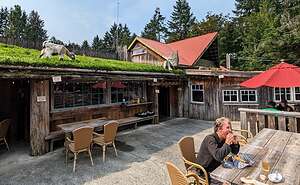 Herb and the goat chowing downOn our drive back to Victoria, where we would conclude our stay on Vancouver Island, we found two interesting stops along the way.
Herb and the goat chowing downOn our drive back to Victoria, where we would conclude our stay on Vancouver Island, we found two interesting stops along the way.
The first was the Old Country Market in the little town of Coombs, famous for the fact that several goats graze on its roof. It has become a very popular attraction and draws crowds, as was evidenced by the difficulty of finding parking anywhere near it.
As promised there was a goat on the roof, but just one. Where were his buddies? When my son was here, he said there were a bunch of them. So, of course, we joined everyone else taking photos of this poor goat just minding his own business.
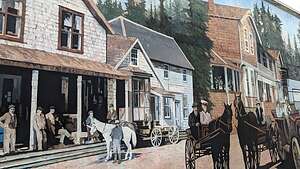 Murals of ChemainusThe Old Country Market was worth a visit, even if there was no goat. It had a bakery, a deli, an ice cream stand, island produce, and lots of nosh.
Murals of ChemainusThe Old Country Market was worth a visit, even if there was no goat. It had a bakery, a deli, an ice cream stand, island produce, and lots of nosh.
We decided to eat there and had some burgers. I especially enjoyed my photo of the goat and Herb grazing.
Next stop along the way was the town of Chemainus, a sleepy little mill town that reinvented itself in the 1980s when its antiquated sawmill was replaced with a more modern mill, resulting in many layoffs.
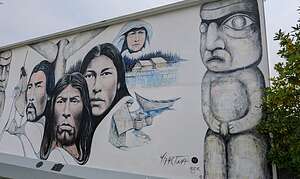 Murals of ChemainusNot wanting to slip into oblivion, the town hired local artists to cover the walls of the town’s commercial building with huge murals depicting the town’s history and culture.
Murals of ChemainusNot wanting to slip into oblivion, the town hired local artists to cover the walls of the town’s commercial building with huge murals depicting the town’s history and culture.
The project was so successful, that in 1983 it won a prestigious downtown revitalization competition against towns and cities from around the world.
It was definitely worth the stop, and we spent an enjoyable hour or so wandering around the town. Even the local Subway shop served as a canvas for a depiction of the town’s sawmill history.
Now, onto Victoria. Fortunately, we wouldn’t have to deal with the Highway 4 road closure we had experienced on the way to Tofino, because they don’t close the road on weekends. As much as II would like to say that it was excellent planning on my part, it was sheer luck, as I didn’t even know about the road closures when planning the trip.
Ucluelet
Friday, August 18, 2023 - 3:30pm by Lolo25 miles and 0.75 hours from our last stop - 2 night stay
Travelogue
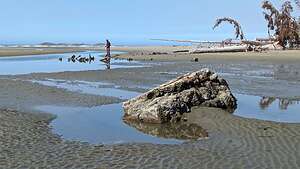 Combers BeachOur next destination was two nights in Ucluelet, about a half hour south of Tofino, also on the western coast of Vancouver Island.
Combers BeachOur next destination was two nights in Ucluelet, about a half hour south of Tofino, also on the western coast of Vancouver Island.
It was too early to check into our hotel, so on the drive south we stopped at Combers Beach, located within the boundaries of the Pacific Rim National Park. From the parking lot, we strolled along a boardwalk through a rather enchanting Sitka Spruce Forest before arriving at a driftwood-strewn beach.
 View from from our balconyOnce at the beach, we turned left and followed Sandhill Creek, which flowed into the sea. It’s one of the less visited beaches along the coast, so if you want peace and quiet, it’s a great place to stop. The whole time we were there, we didn’t see another soul.
View from from our balconyOnce at the beach, we turned left and followed Sandhill Creek, which flowed into the sea. It’s one of the less visited beaches along the coast, so if you want peace and quiet, it’s a great place to stop. The whole time we were there, we didn’t see another soul.
We continued on to the Canadian Princess hotel in Ucluelet, located right on the Ucluelet Harbor. So, this time rather than an ocean view, we had a wonderful view of the harbor right from our balcony. It was nice to change up the view.
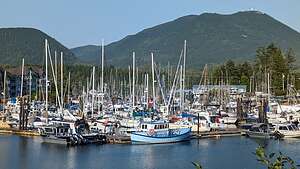 Ucluelet HarborWe went for an early dinner at the Floathouse Bar and Grill, a restaurant literally floating in the harbor, just a short walk from our hotel. Herb had the Blackened Rockfish and I had the Pad Thai Noodle Salad. Mine was good, but not sure why I didn’t order fish in a primarily seafood restaurant. Herb’s looked awfully good.
Ucluelet HarborWe went for an early dinner at the Floathouse Bar and Grill, a restaurant literally floating in the harbor, just a short walk from our hotel. Herb had the Blackened Rockfish and I had the Pad Thai Noodle Salad. Mine was good, but not sure why I didn’t order fish in a primarily seafood restaurant. Herb’s looked awfully good.
A real gem in Ucluelet is the Wild Pacific Trail, a system of trails that carves through old-growth thickets of twisted trunks and ferns and mosses of the temperate coastal rainforest, as it hugs the wild coastline of the Ucluth Peninsula.
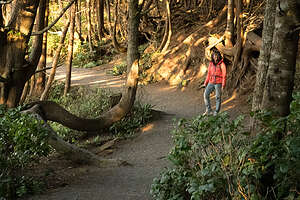 Along the Lighthouse LoopThe trail system is being developed from private, business and government donations to the Wild Pacific Trail Society. The trail is divided into three sections: Lighthouse Loop, Big Beach Section, and Brown's Beach to Ancient Cedars Section.
Along the Lighthouse LoopThe trail system is being developed from private, business and government donations to the Wild Pacific Trail Society. The trail is divided into three sections: Lighthouse Loop, Big Beach Section, and Brown's Beach to Ancient Cedars Section.
This evening we close to walk the Lighthouse Loop section during sunset. The trail starts at the Whale parking lot midway along Coast Guard Road. From there we took the Wild Pacific Coast Trail l in a clockwise direction.
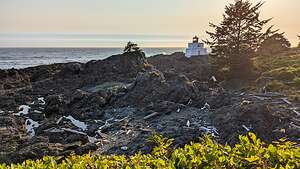 Amphitrite LighthouseI loved photographing the rocks jutting out into the sea, with the slow motion feature of my Google Pixel to soften the movement of the water.
Amphitrite LighthouseI loved photographing the rocks jutting out into the sea, with the slow motion feature of my Google Pixel to soften the movement of the water.
One of the first interesting things we encountered was the amazing array of twisted, weather beaten trees along the trail. I wish I knew what kind of trees they were.
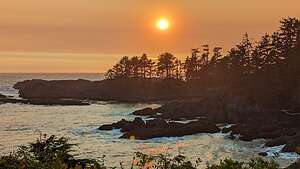 Sunset along the Lighthouse LoopEventually we caught a glimpse through the trees of the iconic Amphitrite Lighthouse keeping watch over Barkley Sound and the Broken Group Islands. This lighthouse was originally built in 1906 in response to the shipwreck of the Pass of Melfort, but it was replaced in 1915 with the current building to better withstand hurricane force storms.
Sunset along the Lighthouse LoopEventually we caught a glimpse through the trees of the iconic Amphitrite Lighthouse keeping watch over Barkley Sound and the Broken Group Islands. This lighthouse was originally built in 1906 in response to the shipwreck of the Pass of Melfort, but it was replaced in 1915 with the current building to better withstand hurricane force storms.
I was anxious to get to a sport along the trail called Inspiration Point in time for sunset. We did and were able to capture a lovely sunset via stairs cut artistically into the headlands.
 Artists Loop along the Wild Pacific TrailIt took us just under an hour to do the 2.3 mile loop, but that was because we stopped so often to take photos of the beautiful scenery.
Artists Loop along the Wild Pacific TrailIt took us just under an hour to do the 2.3 mile loop, but that was because we stopped so often to take photos of the beautiful scenery.
The next morning we set out to explore the Big Beach Section of the Wild Pacific Trail. We parked at the Brown’s Beach section in a parking lot north of the Black Rock Oceanfront Resort on Marine Drive. After a short section of trail following the road, we reached the wilderness coastal trail.
 Scouting out the wave for sunsetA little less than a mile from Brown’s Beach we came to the extremely picturesque Artists Loop, which begins in the forest canopy but quickly opens up onto wind-swept cliffs where the wild coastline becomes more and more dramatic with each step. It was by far the most photogenic section of the Wild Pacific Trail.
Scouting out the wave for sunsetA little less than a mile from Brown’s Beach we came to the extremely picturesque Artists Loop, which begins in the forest canopy but quickly opens up onto wind-swept cliffs where the wild coastline becomes more and more dramatic with each step. It was by far the most photogenic section of the Wild Pacific Trail.
All along the way there were side trails leading to storm-watching decks and platforms called “Painter’s Perches” with unique views and vistas of the wild coastline.
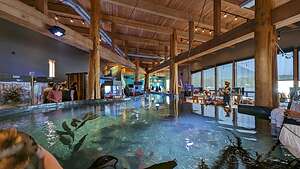 Ucluelet Catch-and-Release AquariumWe knew this would be a great place to come back for sunset photography, so Herb began marking various places along the way on Gaia. One place in particular attracted us, and we named it “the Wave,” because it looked like a large wave made of stone frozen in time.
Ucluelet Catch-and-Release AquariumWe knew this would be a great place to come back for sunset photography, so Herb began marking various places along the way on Gaia. One place in particular attracted us, and we named it “the Wave,” because it looked like a large wave made of stone frozen in time.
We turned around at 2.7 miles at a place called Rocky Bluffs and walked back from whence we came, with the intent of repeating this hike at sunset.
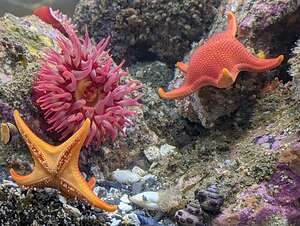 Residents of the Ucluelet AquariumIn the meantime, we had the whole afternoon to explore the tiny village of Ucluelet. So, as I often do, I looked on Trip Advisor for things to do in the nearby area. The #1 thing to do in Ucluelet was unsurprisingly the Wild Pacific Trail. Okay, good. Done that and would repeat tonight. Coming in second was the Ucluelet Aquarium.
Residents of the Ucluelet AquariumIn the meantime, we had the whole afternoon to explore the tiny village of Ucluelet. So, as I often do, I looked on Trip Advisor for things to do in the nearby area. The #1 thing to do in Ucluelet was unsurprisingly the Wild Pacific Trail. Okay, good. Done that and would repeat tonight. Coming in second was the Ucluelet Aquarium.
At first I balked at the admission price - $14 Canadian dollars for seniors (around $10.30 U.S.), but based on the positive reviews, we figured we’d give it a try.
The aquarium is rather unique in that it is a collect-and-release aquarium, meaning its residents are not permanent, but literally just passing through.
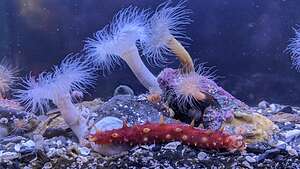 Residents of the Ucluelet AquariumAll of the specimens in the exhibits are collected from nearby Barkley Sound and Clayoquot Sound, and are seasonally released back into the ocean. Most specimens are collected either by scuba divers, by hand at low tide, or by hand seining beaches, whereby specific target animals are removed from the net and the rest are returned to the water.
Residents of the Ucluelet AquariumAll of the specimens in the exhibits are collected from nearby Barkley Sound and Clayoquot Sound, and are seasonally released back into the ocean. Most specimens are collected either by scuba divers, by hand at low tide, or by hand seining beaches, whereby specific target animals are removed from the net and the rest are returned to the water.
Despite its smallness, there were a lot of interesting animals on display: rockfish, crabs, bivalves, feather duster worms, bay pipefish, sea anemones, sea pen, and many more. There were even a few touch tanks including one where I got to pet a large sea cucumber.
Then at the end of the season, the staff says goodbye and the animals are returned to their natural habitats.
 Lolo scrambling over the sharp rocks to get the shotThe aquarium was definitely worth a visit.
Lolo scrambling over the sharp rocks to get the shotThe aquarium was definitely worth a visit.
Afterwards we had some very good pizza at nearby Shipwreck Pizza before heading back out to the Wild Pacific Trail for sunset. They had three TV sets going, two with sports and oddly enough, one with Bob Ross doing one of his rapid paintings. The man is amazing. He painted an entire landscape in the time it took for us to eat a pizza.
This time we pretty much focused (no pun intended) on the Artists Loop section of the trail as that was by far the most dramatic.
 "The Wave" at sunsetWe revisited the spots Herb had marked on Gaia, but by far my favorite was still the rock formation down on the beach that we had named the “Wave” because of its obvious resemblance to a large wave fixed in position just as it was about to crest.
"The Wave" at sunsetWe revisited the spots Herb had marked on Gaia, but by far my favorite was still the rock formation down on the beach that we had named the “Wave” because of its obvious resemblance to a large wave fixed in position just as it was about to crest.
I tried to get up a bit too close and personal, but the rocks I had to clamber over almost tore my pants and I did scratch my phone.
Not sure if we got any good photos, but it certainly was a beautiful walk. Sometimes I wonder if I shouldn’t just put the camera away and look.
Tomorrow we would head to Victoria for a night.
